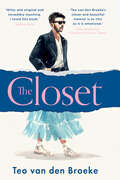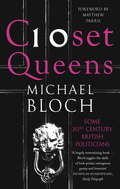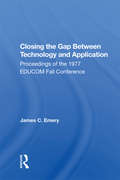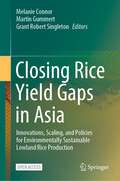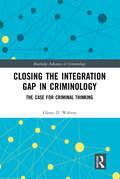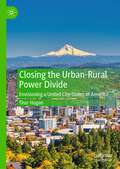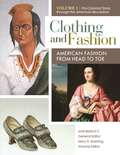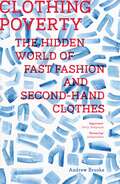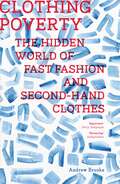- Table View
- List View
Closely Watched Films (Routledge Revivals): The Czechoslovak Experience
by Antonín J. LiehmFirst published in 1974, this book collects interviews with leading Czechslovak filmmakers conducted mostly between 1967 and 1969. This was a period of immense upheaval beginning with the attack of the Czechoslovak establishment on the Union of Writers in 1967, continuing through the liberalisation of the Prague Spring in January 1968 and ended with the Soviet invasion in August and subsequent ‘Normalization’ process in April 1969. It records the testimony of several generations of filmmakers and their attempts to answer the questions about the purpose and meaning of film before and during this period. This book will be of interest to students of film and cultural history.
Closely Watched Films (Routledge Revivals): The Czechoslovak Experience
by Antonín J. LiehmFirst published in 1974, this book collects interviews with leading Czechslovak filmmakers conducted mostly between 1967 and 1969. This was a period of immense upheaval beginning with the attack of the Czechoslovak establishment on the Union of Writers in 1967, continuing through the liberalisation of the Prague Spring in January 1968 and ended with the Soviet invasion in August and subsequent ‘Normalization’ process in April 1969. It records the testimony of several generations of filmmakers and their attempts to answer the questions about the purpose and meaning of film before and during this period. This book will be of interest to students of film and cultural history.
Closer to Freedom: Enslaved Women and Everyday Resistance in the Plantation South (Gender and American Culture)
by Stephanie M. CampRecent scholarship on slavery has explored the lives of enslaved people beyond the watchful eye of their masters. Building on this work and the study of space, social relations, gender, and power in the Old South, Stephanie Camp examines the everyday containment and movement of enslaved men and, especially, enslaved women. In her investigation of the movement of bodies, objects, and information, Camp extends our recognition of slave resistance into new arenas and reveals an important and hidden culture of opposition.Camp discusses the multiple dimensions to acts of resistance that might otherwise appear to be little more than fits of temper. She brings new depth to our understanding of the lives of enslaved women, whose bodies and homes were inevitably political arenas. Through Camp's insight, truancy becomes an act of pursuing personal privacy. Illegal parties ("frolics") become an expression of bodily freedom. And bondwomen who acquired printed abolitionist materials and posted them on the walls of their slave cabins (even if they could not read them) become the subtle agitators who inspire more overt acts. The culture of opposition created by enslaved women's acts of everyday resistance helped foment and sustain the more visible resistance of men in their individual acts of running away and in the collective action of slave revolts. Ultimately, Camp argues, the Civil War years saw revolutionary change that had been in the making for decades.
The Closet: The Eighteenth-Century Architecture of Intimacy
by Danielle BobkerA literary and cultural history of the intimate space of the eighteenth-century closet—and how it fired the imaginations of Pepys, Sterne, Swift, and so many other writers Long before it was a hidden storage space or a metaphor for queer and trans shame, the closet was one of the most charged settings in English architecture. This private room provided seclusion for reading, writing, praying, dressing, and collecting—and for talking in select company. In their closets, kings and duchesses shared secrets with favorites, midwives and apothecaries dispensed remedies, and newly wealthy men and women expanded their social networks. In The Closet, Danielle Bobker presents a literary and cultural history of these sites of extrafamilial intimacy, revealing how, as they proliferated both in buildings and in books, closets also became powerful symbols of the unstable virtual intimacy of the first mass-medium of print.Focused on the connections between status-conscious—and often awkward—interpersonal dynamics and an increasingly inclusive social and media landscape, The Closet examines dozens of historical and fictional encounters taking place in the various iterations of this room: courtly closets, bathing closets, prayer closets, privies, and the "moving closet" of the coach, among many others. In the process, the book conjures the intimate lives of well-known figures such as Samuel Pepys and Laurence Sterne, as well as less familiar ones such as Miss Hobart, a maid of honor at the Restoration court, and Lady Anne Acheson, Swift's patroness. Turning finally to queer theory, The Closet discovers uncanny echoes of the eighteenth-century language of the closet in twenty-first-century coming-out narratives.Featuring more than thirty illustrations, The Closet offers a richly detailed and compelling account of an eighteenth-century setting and symbol of intimacy that continues to resonate today.
The Closet: The Eighteenth-Century Architecture of Intimacy
by Danielle BobkerA literary and cultural history of the intimate space of the eighteenth-century closet—and how it fired the imaginations of Pepys, Sterne, Swift, and so many other writers Long before it was a hidden storage space or a metaphor for queer and trans shame, the closet was one of the most charged settings in English architecture. This private room provided seclusion for reading, writing, praying, dressing, and collecting—and for talking in select company. In their closets, kings and duchesses shared secrets with favorites, midwives and apothecaries dispensed remedies, and newly wealthy men and women expanded their social networks. In The Closet, Danielle Bobker presents a literary and cultural history of these sites of extrafamilial intimacy, revealing how, as they proliferated both in buildings and in books, closets also became powerful symbols of the unstable virtual intimacy of the first mass-medium of print.Focused on the connections between status-conscious—and often awkward—interpersonal dynamics and an increasingly inclusive social and media landscape, The Closet examines dozens of historical and fictional encounters taking place in the various iterations of this room: courtly closets, bathing closets, prayer closets, privies, and the "moving closet" of the coach, among many others. In the process, the book conjures the intimate lives of well-known figures such as Samuel Pepys and Laurence Sterne, as well as less familiar ones such as Miss Hobart, a maid of honor at the Restoration court, and Lady Anne Acheson, Swift's patroness. Turning finally to queer theory, The Closet discovers uncanny echoes of the eighteenth-century language of the closet in twenty-first-century coming-out narratives.Featuring more than thirty illustrations, The Closet offers a richly detailed and compelling account of an eighteenth-century setting and symbol of intimacy that continues to resonate today.
The Closet: A Coming-of-age Story Of Love, Awakenings And The Clothes That Made (and Saved) Me
by Teo van den BroekeThroughout his life, clothes have provided an outlet through which journalist Teo van den Broeke understands both himself and the world around him.
Closet Queens: Some 20th Century British Politicians
by Michael BlochCloset Queens is a fascinating study of gay men in twentieth century British politics, from Lord Rosebery and Lord Beauchamp in Edwardian times to Michael Portillo and Peter Mandelson in our own era. As all homosexual activity was illegal until 1967, and exposure meant ruin and disgrace, such men were obliged either to repress their sexual feelings or else lead double lives, indulging their tastes secretly while respectably married with children.The need to cover up their sexuality, while causing problems and disappointments, often sharpened their skills as politicians - they were masters of secrecy and subterfuge, and knew how to take calculated risks. An entertaining and insightful account of some extraordinary personalities, Closet Queens opens doors into a hidden world.
Closet Space: Geographies of Metaphor from the Body to the Globe (Critical Geographies Ser.)
by Michael P. BrownIs the closet just a metaphor? Closet Space provides a highly original account of the spatial metaphor of "the closet", and is the first geography text to focus on this important issue. Using a variety of research techniques and materials, the book explores the closet through texts including:* the oral histories of gay men in the UK and US* the sexualised landscape of a New Zealand city* the national census of Britain and the US* international travel guides and traveloguesand refers to the work of Butler, Lefebvre and Foucault.
Closet Space: Geographies of Metaphor from the Body to the Globe
by Michael P. BrownIs the closet just a metaphor? Closet Space provides a highly original account of the spatial metaphor of "the closet", and is the first geography text to focus on this important issue. Using a variety of research techniques and materials, the book explores the closet through texts including:* the oral histories of gay men in the UK and US* the sexualised landscape of a New Zealand city* the national census of Britain and the US* international travel guides and traveloguesand refers to the work of Butler, Lefebvre and Foucault.
Closing Children's Homes: An End to Residential Child care? (PDF)
by David Berridge David CliffeThis ebook reports on the unprecedented and radical step taken by Warwickshire Social Services Department when, in 1986, it closed the last of its children's homes. This book examines the background to these developments, the reasons for them and their consequences. The findings are set in the context of the crisis of confidence in residential child care that occurred in the early 1990's culminating in the Pindown Report on Staffordshire which revealed an alarming catalogue of inhuman and degrading treatment of children in residential care. This research, undertaken by NCB, reports findings that have major national and international significance. The future role of children's homes is in question and this study examines whether foster care, in particular, is more effective at meeting children's needs than residential care. Young people's own views are included and the work is presented very much in the context of the Children Act 1989.
Closing The Gap Between Technology And Application
by James C. EmeryThis book presents analyses, from three points of view, of the use of computing technology in higher education. It considers application areas including office automation, distributed academic computing, distributed administrative computing, instructional systems, and information resources.
Closing The Gap Between Technology And Application
by James C. EmeryThis book presents analyses, from three points of view, of the use of computing technology in higher education. It considers application areas including office automation, distributed academic computing, distributed administrative computing, instructional systems, and information resources.
Closing Rice Yield Gaps in Asia: Innovations, Scaling, and Policies for Environmentally Sustainable Lowland Rice Production
by Melanie Connor Martin Gummert Grant Robert SingletonThis open access book contributes not only to the scientific literature on sustainable agricultural development and in particular rice agriculture but also is highly valuable to assist practitioners, projects, and policymakers due to its sections on reducing carbon footprint, agricultural innovations, and lessons learned from a multi-country/multi-stages development project. The scope of the book is conceived as a detailed documentation of the implementation, dissemination, and impact of the CORIGAP project in Sri Lanka, Myanmar, Thailand, China, Vietnam, and Indonesia, with spill-over to Cambodia and the Philippines. It pulls together actionable research findings with the experience of bringing these findings into use. The aim of the book is to provide a wide array of pathways to impact for sustainable rice production in lowland irrigated rice-based agricultural systems. The book is written by local actors of the rice value chain, researchers, and engineers working on a range of best management practices, climate-smart rice production innovations, knowledge translation, and dissemination, as well as decision-making and policy aspects. It is envisioned that the contents of the book can be translated into messages that can help farmers, extension workers, policymakers, and funders of agricultural development, decide on implementing best management practices and climate-smart technologies in their agroecological systems by presenting the technological/practical options along the rice value chain and the partnerships and business models required for their implementation. The book is aimed at practitioners, extension specialists, researchers, and engineers interested in information on current best management practices, sustainable, and climate-smart rice production and constraints that need further investigation. Furthermore, the book is also aimed at policymakers and agricultural development funders required by public opinion and legally binding agreements to reduce greenhouse gas emissions, conserve biodiversity and increase agroecological practices, who are looking for research-based evidence to guide policymaking and implementation.
Closing the Golden Door: Asian Migration and the Hidden History of Exclusion at Ellis Island
by Anna Pegler-GordonThe immigration station at New York's Ellis Island opened in 1892 and remained the largest U.S. port for immigrant entry until World War I. In popular memory, Ellis Island is typically seen as a gateway for Europeans seeking to join the "great American melting pot." But as this fresh examination of Ellis Island's history reveals, it was also a major site of immigrant detention and exclusion, especially for Chinese, Japanese, and other Asian travelers and maritime laborers who reached New York City from Europe, the Americas and the Caribbean, and even within the United States. And from 1924 to 1954, the station functioned as a detention camp and deportation center for a range of people deemed undesirable. Anna Pegler-Gordon draws on immigrants' oral histories and memoirs, government archives, newspapers, and other sources to reorient the history of migration and exclusion in the United States. In chronicling the circumstances of those who passed through or were detained at Ellis Island, she shows that Asian exclusion was both larger in scope and more limited in force than has been previously recognized.
Closing the Integration Gap in Criminology: The Case for Criminal Thinking (Routledge Advances in Criminology)
by Glenn D. WaltersClosing the Integration Gap in Criminology: The Case for Criminal Thinking offers a multi -stage model of theory integration that organizes verified risk factors around the construct of criminal thinking to provide an exemplar working paradigm for criminology. In the model, once relevant risk factors have been identified, they are organized into triads —three-variable networks of antecedent, mediating, or moderating effects—and then those triads are combined into clusters of thematically related constructs. While debate continues to rage over how to handle the burgeoning number of theories in criminology, little significant progress has been made in reducing the number of criminological theories. This book argues that theoretical integration is vital to the continued viability of criminological theory and to the growth and development of criminology as a scientific discipline. It posits that criminal thinking may be useful as a core variable in constructing a useful integrated theory for criminology, and maps out a plan for scholars to organize information for further study. The innovative theoretical approach in this book is essential reading for students, academics, and researchers in both criminology and forensic psychology concerned with the reduction of crime via scientific inquiry.
Closing the Integration Gap in Criminology: The Case for Criminal Thinking (Routledge Advances in Criminology)
by Glenn D. WaltersClosing the Integration Gap in Criminology: The Case for Criminal Thinking offers a multi -stage model of theory integration that organizes verified risk factors around the construct of criminal thinking to provide an exemplar working paradigm for criminology. In the model, once relevant risk factors have been identified, they are organized into triads —three-variable networks of antecedent, mediating, or moderating effects—and then those triads are combined into clusters of thematically related constructs. While debate continues to rage over how to handle the burgeoning number of theories in criminology, little significant progress has been made in reducing the number of criminological theories. This book argues that theoretical integration is vital to the continued viability of criminological theory and to the growth and development of criminology as a scientific discipline. It posits that criminal thinking may be useful as a core variable in constructing a useful integrated theory for criminology, and maps out a plan for scholars to organize information for further study. The innovative theoretical approach in this book is essential reading for students, academics, and researchers in both criminology and forensic psychology concerned with the reduction of crime via scientific inquiry.
Closing the Justice Gap for Adult and Child Sexual Assault: Rethinking the Adversarial Trial
by Anne CossinsThis book examines the justice gap and trial process for sexual assault against both adults and children in two jurisdictions: England and Wales and New South Wales, Australia. Drawing on decades of research, it investigates the reality of the policing and prosecution of sexual assault offences – often seen as one of the ‘hardest crimes to prosecute’ – across two similar jurisdictions. Despite the introduction of the many reform options detailed in the book, satisfactory outcomes for victims and the public are still difficult to obtain.Cossins takes a new approach by examining the nature and effects of adversarialism on vulnerable witnesses, jury decision-making and the structures of power within the trial process, to show how, and at what points, that process is weighted against complainants of sexual assault, in order to make evidence-based suggestions for reform. She argues that this justice gap is a result of a moralistic adversarial culture which fosters myths and misconceptions about rape and child sexual assault, thus requiring the prosecution to prove a complainant’s moral worthiness. She argues this culture can only be eliminated by a radical replacement of the adversarial system with a trauma-informed system. By reviewing the relevant psychological literature, this book documents the triggers for re-traumatisation within an adversarial trial, and discusses the reform measures that would be necessary to transform the sexual assault trial from one where the complainant’s moral worthiness is ‘on trial’ to a fully functioning trauma-informed system. It speaks to students and academics across subjects including law, criminology, gender studies and psychology, and practitioners in law and victim services, as well as policy-makers.
Closing the Urban-Rural Power Divide: Envisioning a United City-States of America
by Thor HoganThis book proposes a radical reorganization of political and electoral power to address the current political imbalance between urban and rural populations in the United States. Hogan argues that, despite being smaller in population, a “financialist-ruralist coalition” has effectively used the Constitution—especially equal representation in the Senate—to create an anti-urban “vetocracy.” This political imbalance protects the interests of the financial elite and rural cultural conservatives, while effectively blocking urban interests, particularly regarding the adoption of a broad range of structural reforms and progressive policy preferences. By re-dividing many of the largest federated states into smaller city-states, the book posits, the United States would reduce the ability of non-urban interests to control the Senate. This would allow an empowered urbanite alliance to pass the forward-looking legislation the nation needs to remain internationally competitive in the coming decades.
Clothed in Meaning: Literature, Labor, and Cotton in Nineteenth-Century America (Class : Culture)
by Sylvia Jenkins CookThe rise of both the empire of cotton and the empire of fashion in the nineteenth century brought new opportunities for sartorial self-expression to millions of ordinary people who could now afford to dress in style and assert their physical presence. Millions of laborers toiling in cotton fields and producing cotton cloth in industrial mills faced a brutal reality of exploitation, servitude, and regimentation—yet they also had a profound desire to express their selfhood. Another transformative force of this era—the rise of literary publication and the radical extension of literacy to the working class—opened an avenue for them to do so. Cloth and clothing provide potent tropes not only for physical but also for intellectual forms of self-expression. Drawing on sources ranging from fugitive slave narratives, newspapers, manifestos, and mill workers’ magazines to fiction, poetry, and autobiographies, Clothed in Meaning examines the significant part played by mill workers and formerly enslaved people, many of whom still worked picking cotton, in this revolution of literary self-expression. They created a new literature from their palpable daily intimacy with cotton, cloth, and clothing, as well as from their encounters with grimly innovative modes of work. In the materials of their labor they discovered vivid tropes for formulating their ideas and an exotic and expert language for articulating them. The harsh conditions of their work helped foster in their writing a trenchant irony toward the demeaning reduction of human beings to “hands” whose minds were unworthy of interest. Ultimately, Clothed in Meaning provides an essential examination of the intimate connections between oppression and luxury as recorded in the many different voices of nineteenth-century labor.
Clothing and Fashion [4 volumes]: American Fashion from Head to Toe [4 volumes]
by José Blanco F., General Editor Mary D. Doering, Volume EditorThis unique four-volume encyclopedia examines the historical significance of fashion trends, revealing the social and cultural connections of clothing from the precolonial times to the present day.This sweeping overview of fashion and apparel covers several centuries of American history as seen through the lens of the clothes we wear—from the Native American moccasin to Manolo Blahnik's contribution to stiletto heels. Through four detailed volumes, this work delves into what people wore in various periods in our country's past and why—from hand-crafted family garments in the 1600s, to the rough clothing of slaves, to the sophisticated textile designs of the 21st century.More than 100 fashion experts and clothing historians pay tribute to the most notable garments, accessories, and people comprising design and fashion. The four volumes contain more than 800 alphabetical entries, with each volume representing a different era. Content includes fascinating information such as that beginning in 1619 through 1654, every man in Virginia was required to plant a number of mulberry trees to support the silk industry in England; what is known about the clothing of enslaved African Americans; and that there were regulations placed on clothing design during World War II. The set also includes color inserts that better communicate the visual impact of clothing and fashion across eras.
Clothing and Fashion [4 volumes]: American Fashion from Head to Toe [4 volumes]
This unique four-volume encyclopedia examines the historical significance of fashion trends, revealing the social and cultural connections of clothing from the precolonial times to the present day.This sweeping overview of fashion and apparel covers several centuries of American history as seen through the lens of the clothes we wear—from the Native American moccasin to Manolo Blahnik's contribution to stiletto heels. Through four detailed volumes, this work delves into what people wore in various periods in our country's past and why—from hand-crafted family garments in the 1600s, to the rough clothing of slaves, to the sophisticated textile designs of the 21st century.More than 100 fashion experts and clothing historians pay tribute to the most notable garments, accessories, and people comprising design and fashion. The four volumes contain more than 800 alphabetical entries, with each volume representing a different era. Content includes fascinating information such as that beginning in 1619 through 1654, every man in Virginia was required to plant a number of mulberry trees to support the silk industry in England; what is known about the clothing of enslaved African Americans; and that there were regulations placed on clothing design during World War II. The set also includes color inserts that better communicate the visual impact of clothing and fashion across eras.
Clothing and Landscape in Victorian England: Working-Class Dress and Rural Life
by Rachel WorthAt the beginning of the Victorian period, most of England's population lived in the countryside; by its end, the balance had tipped towards living in urban and suburban spaces. In the context of this rapidly changing world, Rachel Worth explores the ways in which the clothing of the rural working classes was represented visually in paintings and photographs and by the literary sources of documentary, autobiography and fiction, as well as by the particular pattern of survival and collection by museums of garments of rural provenance. Clothing and Landscape in Victorian EnglandRachel Worth explores ways in which clothing and how it is represented throws light on wider social and cultural aspects of society, as well as how 'traditional' styles of dress, like men's smock-frocks or women's sun-bonnets, came to be replaced by 'fashion'. Her compelling study, with black & white and colour illustrations, both adds a broader dimension to the history of dress by considering it within the social and cultural context of its time and discusses how clothing enriches our understanding of the social history of the Victorian period.
Clothing Poverty: The Hidden World of Fast Fashion and Second-Hand Clothes
by Andrew Brooks'An interesting and important account.'Daily TelegraphHave you ever stopped and wondered where your jeans came from? Who made them and where? Ever wondered where they end up after you donate them for recycling?Following a pair of jeans, Clothing Poverty takes the reader on a vivid around-the-world tour to reveal how clothes are manufactured and retailed, bringing to light how fast fashion and clothing recycling are interconnected. Andrew Brooks shows how recycled clothes are traded across continents, uncovers how retailers and international charities are embroiled in commodity chains which perpetuate poverty, and exposes the hidden trade networks which transect the globe.Stitching together rich narratives, from Mozambican markets, Nigerian smugglers and Chinese factories to London's vintage clothing scene, TOMS shoes and Vivienne Westwood's ethical fashion lines, Brooks uncovers the many hidden sides of fashion.
Clothing Poverty: The Hidden World of Fast Fashion and Second-Hand Clothes
by Andrew BrooksHave you ever stopped and wondered where your jeans came from? Who made them and where? Ever wondered where they end up after you donate them for recycling?Following a pair of jeans, Clothing Poverty takes the reader on a vivid around-the-world tour to reveal how clothes are manufactured and retailed, bringing to light how fast fashion and recycling are interconnected. Andrew Brooks shows how recycled clothes are traded across continents, uncovers how retailers and international charities are embroiled in commodity chains which perpetuate poverty, and exposes the hidden trade networks which transect the globe.In this new and updated edition, Brooks retraces his steps to look at the fashion industry today, and considers how, if at all, the industry has changed in response to mounting consumer pressure for more ethical clothing. Stitching together rich narratives, from Mozambican markets, Nigerian smugglers and Chinese factories to London's vintage clothing scene, TOMS shoes and Vivienne Westwood's ethical fashion lines, Brooks uncovers the many hidden sides of fashion.
Clothing Poverty: The Hidden World of Fast Fashion and Second-Hand Clothes
by Andrew Brooks'An interesting and important account.'Daily TelegraphHave you ever stopped and wondered where your jeans came from? Who made them and where? Ever wondered where they end up after you donate them for recycling?Following a pair of jeans, Clothing Poverty takes the reader on a vivid around-the-world tour to reveal how clothes are manufactured and retailed, bringing to light how fast fashion and clothing recycling are interconnected. Andrew Brooks shows how recycled clothes are traded across continents, uncovers how retailers and international charities are embroiled in commodity chains which perpetuate poverty, and exposes the hidden trade networks which transect the globe.Stitching together rich narratives, from Mozambican markets, Nigerian smugglers and Chinese factories to London's vintage clothing scene, TOMS shoes and Vivienne Westwood's ethical fashion lines, Brooks uncovers the many hidden sides of fashion.



